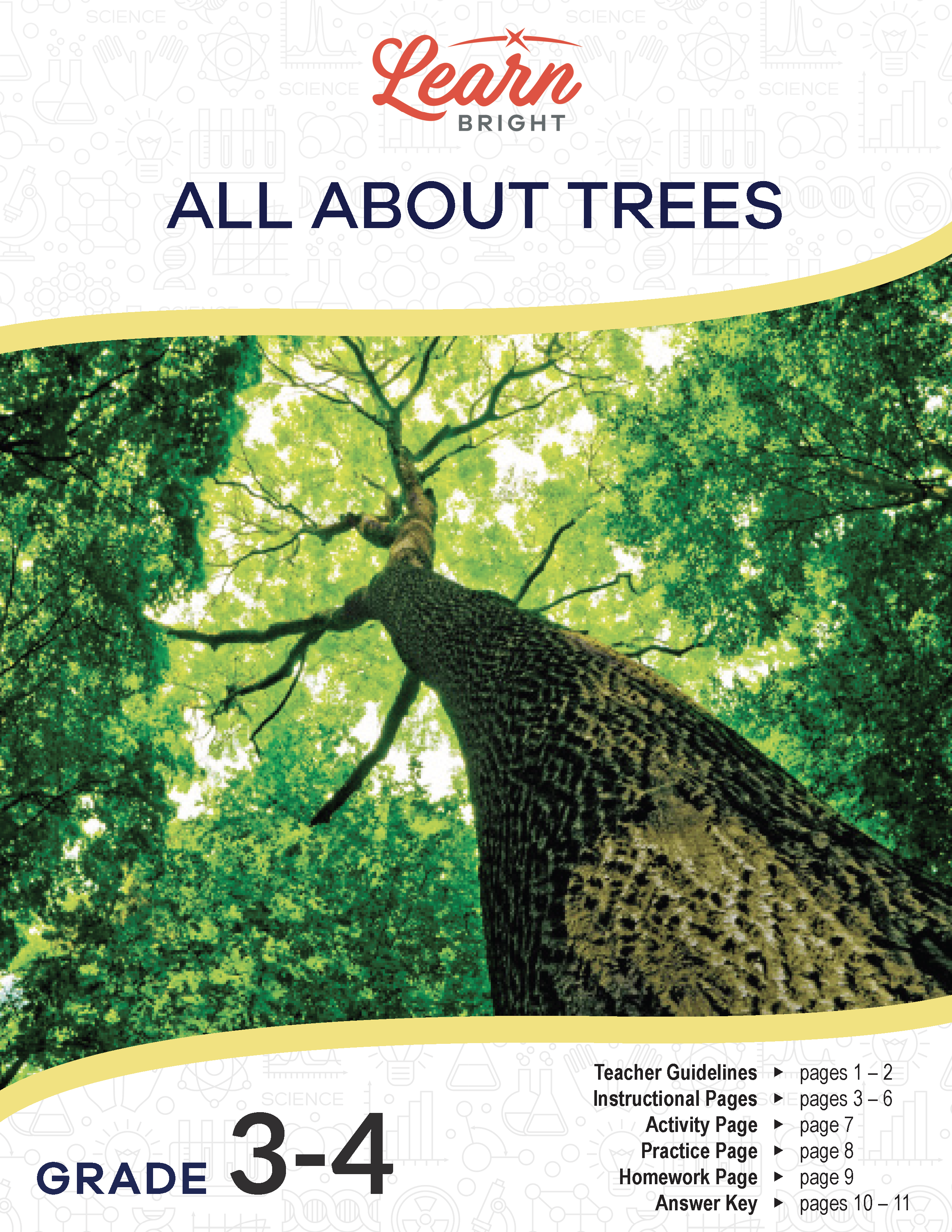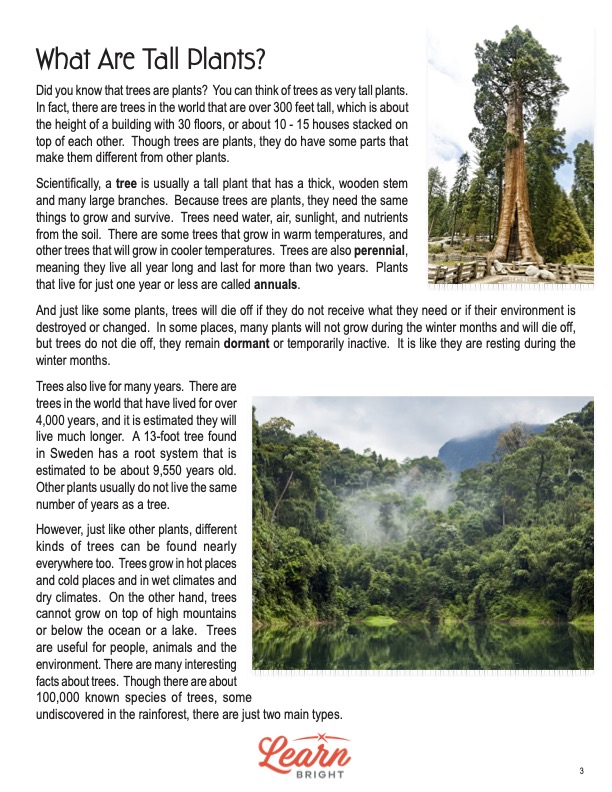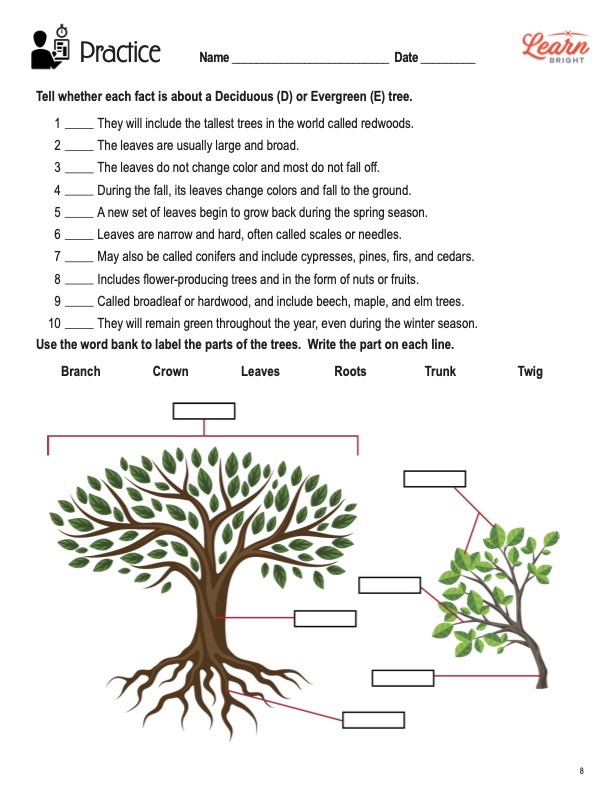Description
What our All about Trees lesson plan includes
Lesson Objectives and Overview: All about Trees teaches students about the traits of a tree and its different parts. Students will discover many different types of trees and learn how they might differ from each other. By the end of the lesson, they will also be able to explain why trees are important to the environment. This lesson is for students in 3rd grade and 4th grade.
Classroom Procedure
Every lesson plan provides you with a classroom procedure page that outlines a step-by-step guide to follow. You do not have to follow the guide exactly. The guide helps you organize the lesson and details when to hand out worksheets. It also lists information in the yellow box that you might find useful. You will find the lesson objectives, state standards, and number of class sessions the lesson should take to complete in this area. In addition, it describes the supplies you will need as well as what and how you need to prepare beforehand. For this lesson, you will need to provide construction paper, glue, scissors, tap, markers, and scratch paper in addition to the handouts. Make sure you provide construction paper in a variety of colors.
Options for Lesson
This lesson includes several suggestions in the “Options for Lesson” section of the classroom procedure page for additional activities or tasks you could add to the lesson. A few of these ideas relate specifically to the activity portion of the lesson. You may want students to work alone or in groups for the activity rather than in pairs. You could also add additional supplies, such as yarn and glitter, to those you provide for the activity. Another option is to visit an area on or near school grounds where students can identify different types of trees and point out their parts.
You could find coloring pages of trees as an extra activity. Another idea is to have students write tree-related stories or poems. If you can time it right, you could celebrate Arbor Day, either just the day or for a week, and teach additional lessons that relate to the environment and trees. Another suggestion is to invite a tree expert to speak to the class and answer any questions they have on the subject. One final idea is to have students collect the leaves from different kinds of trees and match them to the right type using images from the internet.
Teacher Notes
The paragraph on this page provides a little extra information and guidance for you as prepare. It mentions that since trees are everywhere, students will hopefully see them in a new light and perspective after the lesson. You can use the lines on this page to write down any last-minute ideas or thoughts before presenting the lesson to your students.
ALL ABOUT TREES LESSON PLAN CONTENT PAGES
Tall Plants
The All about Trees lesson plan contains four pages of content. Students will first learn that trees are a type of plant — a very, very tall plant! Some trees rise over 300 feet tall, which is about the height of a building with 30 floors. In order to be a tree, a plant must have a few specific traits that not all plants have in common.
A tree is usually a tall plant with a thick, wooden stem and many large branches. At least, this is what a mature tree should have. Young trees would not have thick stems and many large branches yet. Because trees are plants, they need the same things to grow and survive, including water, sunlight, air, and nutrients from the soil. Some of these tall plants grow best in warm temperatures while others will only thrive in cooler temperatures. These plants are perennial, meaning that they live all year long and last for more than just two years. Plants that live for just one year or less are called annuals.
Students will learn that trees can die off if they do not receive what they need or if someone or something threatens to destroy or change their environment. In some places, many plants won’t grow during winter months and instead die off. Trees tend instead to simply remain dormant (temporarily inactive), like they need to rest during those cold months.
Cool Facts
As mentioned, trees live for many years. There are some that have been alive for over 4,000 years, and scientists estimate that they will live much longer. A 13-foot tree in Sweden has a root system that people estimate to be around 9,550 years old! Other plants usually can’t live as long as trees do, even under the best circumstances.
Different kinds of trees live nearly all over the world. They can grow in hot places and cold places, and in both wet and dry climates. On the other hand, they cannot grow on the tops of high mountains or below oceans or lakes. They are incredibly useful to people and animals, as well as the environment. Scientists have discovered around 100,000 species of trees, but they still haven’t discovered some that exist in rainforests.
Types of Trees and How They Grow
The All about Trees lesson plan next explains that there are two main categories of trees that all other kinds would fall into: deciduous and evergreen. Another name for deciduous trees are broadleaf or hardwood trees. Examples include maple, oak, elm, and birch. The leaves of these trees are large and broad. During the fall, they fall off, and new sets of leaves begin to grow back in the spring. Some of these trees produce flowers, sometimes in the form of fruits or nuts that people or other animals can eat.
Another name for evergreens is conifers. Examples include cypress, redwood, fir, and cedar. The leaves are narrow and hard, often referred to as needles or scales. These trees remain green throughout the whole year because their leaves don’t change color. This group includes the tallest trees in the world—the Redwoods—which are in California.
Trees grow just as other plants do, through the process of photosynthesis. Their roots help them grow as well. The roots can be several feet below ground or far away from the tree’s base. They soak up water and nutrients. A tree’s flowers and fruits are also important for growth because they are the source of their seeds. Water, air, or animals transport the seeds to other places, and then new trees grow from those seeds.
Trees grow at the tips of their branches, deep in the ground at the roots, and wider in the trunks and crowns. The bark of the trunk and branches helps protect the plant from animals and diseases. During the winter, trees stop growing, and their trunk forms a ring. Each ring counts as one year of growth, making it easy to discover the age of a tree if it has fallen or been cut down.
Why Are Trees Important?
Students will next learn why trees are important. For humans, trees provide wood for buildings and other products and pulp for making paper. People can use fallen wood as firewood to keep warm. They also breathe in the oxygen that the plants release into the atmosphere. Trees also provide food, such as fruits, nuts, and sap.
For many animals, trees provide homes. Insects, birds, and many other animals use trees as their shelter. These tall plants also provide food to the animals. When they die and decompose, they support small organisms.
The environment also benefits greatly from trees. Trees cleanse the air and help keep it healthy by absorbing carbon dioxide and releasing oxygen into the air. In many places, they beautify the area and provide shade, like in parks. They also provide shelter from wind and help prevent flooding.
Without trees or plants in general, people and other animals could not live. It is very important to take care of them and protect them from damage or destruction. The lesson outlines a few ways students can help trees, such as recycling cardboard boxes and other paper, borrowing or sharing books, visiting forests and staying on the trails, and using paper wisely. The bottom of the last content page provides a diagram that labels the different parts of trees.
Key Terms
Here is a list of the vocabulary words students will learn in this lesson plan:
- Tree: a tall plant with a thick, wooden stem and many large branches (at maturity)
- Perennial: a term to describe plants that live longer than two years
- Annual: a term to describe plants that live for a year or less
- Dormant: temporarily inactive
- Photosynthesis: the process by which plants convert sunlight into a source of energy for food
- Chlorophyll: a chemical in plant leaves that helps with the process of photosynthesis
- Habitat: the home of or place where animals and plants live
ALL ABOUT TREES LESSON PLAN WORKSHEETS
The All about Trees lesson plan includes three worksheets for students to complete throughout the lesson: an activity worksheet, a practice worksheet, and a homework assignment. Each handout will help reinforce students’ grasp of the material they learned about throughout the lesson in different ways. Follow the guidelines on the classroom procedure page to determine when to hand out each assignment.
BUILD A TREE ACTIVITY WORKSHEET
For the activity, students will work with a partner to create a new species of tree. They will design the tree using scratch paper and decide what qualities and traits it will have. You will approve your students’ rough drafts before they finalize their designs. Students must include the six labels in the boxes on the worksheet on their final poster. They can include background images or drawings and must name the tree.
DECIDUOUS OR EVERGREEN PRACTICE WORKSHEET
There are two sections on the practice worksheet. The first section lists 10 statements. Students will read each sentence and decide whether it describes a deciduous (D) or evergreen (E) tree. The second section provides several images of trees for students to label.
ALL ABOUT TREES HOMEWORK ASSIGNMENT
For the homework assignment, students will complete three sections. First, they will match short descriptions about a tree’s importance to whether it relates to human (H), animal (A), or environmental (E) needs. Next, students will circle the correct word of two options to finish 10 sentences. Finally, they will answer nine questions about trees using what they learned in the lesson.
Worksheet Answer Keys
The last two pages of the lesson plan PDF are answer keys for the practice and homework worksheets. The answers are all in red to make it easy for you to compare them to your students’ work. For the most part, students’ responses should match those on the answer keys. On the homework answer key, a couple questions may have some variation, particularly the last question, which asks students to name a few ways they can help prevent the destruction of trees. The answer key provides several options, and it is not exhaustive. If you choose to administer the lesson pages to your students via PDF, you will need to save a new file that omits these pages. Otherwise, you can simply print out the applicable pages and keep these as reference for yourself when grading assignments.











